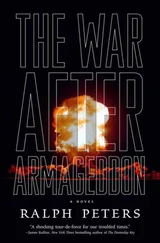“Depth ninety meters, Kapitan.”
The K-480 leveled out just before reaching her ordered depth.
Botkin issued orders to the helm and the K-480 turned onto a new heading inside the hundred-fathom curve. “You wish conference, Captain Scott?” Botkin said in English.
Scott unrolled a chart, which Botkin weighted at the corners with instruction manuals and an ashtray. Alex, Abakov, Botkin, and the starpom navigator pressed in around him. The CCP was silent now except for the low whine of the gyroscope in its binnacle and the hum of fire-control computers and their cooling fans.
Scott swept a hand over the chart and said. “This is our primary search area, the Barents Sea.”
“But this is a huge area to search,” Abakov said.
Scott’s fingers walked the chart, stepping off estimated distances. “Over half a million square miles.” Abakov let out a low whistle.
“Time is also a factor,” Scott said. “We’ve only got days to find the K-363. The message we received from NorFleet in Severomorsk, said they had established an ASW patrol line between Spitsbergen and Novaya Zemlya.” He pointed to them, an archipelago and two large islands north of the Arctic Circle off Russia’s northeast coast.
“Long-range Il-38s are patrolling south toward the Kola Peninsula. NorFleet’s also inserted fifteen MPK patrol craft on a line off the coast of the Kola Peninsula.”
The Kola Peninsula, a tundralike extension of the Scandinavian Peninsula, was fringed with islands and deeply indented with fjords. To the west, Norway’s North Cape, the northernmost point in Europe, marked the invisible line of demarcation between the Barents Sea and the Norwegian Sea.
“NorFleet’s plan is to sweep north and feed more units into the line as they tighten the search box,” Scott said.
“Like a pincer,” Alex said.
“Exactly.”
“And how will they conduct their search?” Abakov said.
“The Il-38s will drop thousands of sonobuoys that can pick up noise from the K-363’s reactor coolant pumps and turbogenerators—the three-hundred-hertz tone. The patrol boats use passive towed sonar arrays. Once they make contact with the sub, they’ll track her, then attack with homing torpedoes.”
“But excuse me, Captain Scott,” Botkin said. “Litvanov has ways of evading detection. He can run ultra quiet. If he is in deep water, there are present thermal layers that deflect sonar, while in shallow water sonar pulses scatter off the bottom and make it difficult to pick a target out of the echoes.”
“Right. We’re up against a clever skipper,” Scott said, “in command of one of the Russian Navy’s best submarines—an Akula, like the one we’re aboard,” he added for Alex and Abakov.
“How capable are they?” asked Abakov.
“They’re comparable to the U.S. Navy’s Improved 688 Los Angeles-class boats. They have a 190- megawatt nuclear reactor and can make over thirty-three knots submerged. They’re 370 feet long and displace about eight thousand tons. They also have advanced sonar suites and are extremely quiet and therefore hard to detect.”
“Most important, the Akulas can dive to almost two thousand feet,” Botkin interjected with barely masked pride.
Abakov bent slightly at the waist to study the chart. “I understand now, but still, the K-363 could be anywhere.”
Scott said, “True, but if Zakayev has plans to attack the summit meeting in St. Petersburg, the K-363 has to stay within range of the target. That narrows the search somewhat.”
The starpom, sandwiched between Scott and Botkin, pointed to a marked spot in the Arctic Ocean far north of the Il-38 patrol line established by NorFleet.
“What he’s pointing to,” Scott said, “represents the maximum theoretical distance from which an SS-N- 21 can reach its target: sixteen hundred nautical miles. But Zakayev won’t stray that far. I’m willing to bet he’s somewhere within a sixty-degree arc due north of Olenya Bay. And not too far from land.”
“Why do you think so?” Alex asked.
“Because,” Scott said, “that’s what I would do if I were going to attack St. Petersburg. The attack is the only thing that matters—not playing tag with the Russian Navy. And the shorter the range to the target, the less chance there is of intercepting and destroying the missile.”
“Even so, how will we ever find the K-363?” said Alex.
“Our best chance is to hear her, get her three-hundred-hertz sound signature on sonar. It won’t be easy, but if we can find her, we can kill her.”
Alex, elbows on the table, put her head in her hands. “Kill her. How?”
“Antisubmarine torpedo,” Scott said.
“Okay, so we or the Russians blow the K-363 to bits. What happens to her nuclear reactor?”
“Depends. If the reactor compartment isn’t damaged, it sinks along with the rest of the ship. If it is— say, the core’s blown open—the fuel assemblies will end up on the sea floor.”
Alex raised her head. “You know, don’t you, that the Russians have been dumping naval reactors at sea for decades. It’s one of the biggest problems Earth Safe has faced. There have been thousands of cubic meters of radioactive waste dumped off the continental shelf of the Kola Peninsula. Then there’s the Atlantic Ocean. In 1986, when the K-219 went down six hundred miles east of Bermuda, she had two reactors and was armed with ballistic missiles. The missiles each had two one megaton warheads with about two hundred pounds of plutonium, which has a half-life of about twenty thousand years. This one wreck has the potential to be an ecological disaster of epic proportions. Someday the reactors and warheads will deteriorate and their radioactive materials will eventually poison the sea. If the K-363’s reactor is destroyed underwater, it will be even worse.”
“You’re assuming it’ll be destroyed,” Scott said.
Alex gave Scott a look. “Can antisubmarine torpedoes differentiate between a reactor compartment and the other compartments of a submarine?”
“No. But Akulas are double-hulled boats, and anti sub torpedoes are designed to penetrate the outer hull, collapse the inner hull, and flood and sink the submarine, not blow the whole ship to hell.”
Abakov said, “If a torpedo hit the outer hull of the reactor compartment, would the explosion be powerful enough to destroy the reactor?”
“Not necessarily. Reactor containment vessels are designed to withstand heavy damage. Chances are the reactor would hold together.”
“Then again, it might not,” Alex said.
Botkin said, “Excuse me, Captain Scott, but Communications say they are receiving a ZEVS.”
Communication links aboard the K-480 had been reconfigured to receive both U.S. and Russian satellite burst transmissions.
“ZEVS?” asked Alex.
“To communicate with submerged submarines, the U.S. and Russian navies broadcast extremely-low-frequency transmissions, known as ELF,” Scott said. “The U.S. ELF transmitter is up on Michigan’s upper peninsula; the Russian ELF transmitter, which they call ZEVS, is located in Archangel.”
“So how do they work?”
“ELF and ZEVS transmissions can penetrate hundreds of feet below the surface of the sea to summon a submarine to periscope depth to receive coded burst transmissions from satellites in earth orbit. Trouble is, ELF data transmission rates are so damn slow that a submarine’s identity code takes minutes to arrive, which forces the sub to loiter near the surface, where it’s vulnerable while recovering its burst transmission.”
“Request permission to come to periscope depth to receive ZEVS,” said the starpom.
“Very well,” Botkin said.
“Kapitan, please double the sonar watch,” Scott said. “I don’t want to be caught napping by Litvanov.”
Читать дальше












